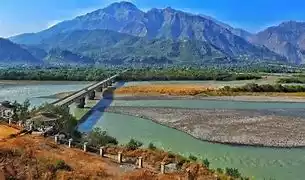A Comprehensive Guide to Reasi District
Introduction
Reasi District, a region steeped in history and natural beauty, is one of the 20 administrative districts in the Indian state of Jammu and Kashmir. Known for its picturesque landscapes, rich cultural heritage, and significant historical landmarks, Reasi is a destination that captures the essence of the region's diverse traditions and natural splendor.
Geography of Reasi District
Located in the foothills of the Himalayas, Reasi District spans an area of approximately 1,719 square kilometers. The district is bounded by Udhampur in the east, Rajouri in the west, Ramban in the north, and Jammu in the south. The Chenab River, one of the major rivers in the Indian subcontinent, flows through the district, adding to its scenic charm and agricultural productivity.
Topography and Climate
The topography of Reasi is characterized by mountainous terrain, lush green valleys, and dense forests. The region experiences a temperate climate, with warm summers and cool winters. The higher altitudes receive significant snowfall during the winter months, making it a favored destination for snow enthusiasts.
Demographics and Culture
As of the latest census, Reasi District has a population of approximately 314,714. The population is a mix of various ethnic groups, including Gujjars, Bakarwals, and Dogras. The predominant languages spoken in the district are Hindi, Dogri, and Urdu.
Cultural Heritage
Reasi boasts a rich cultural heritage, with traditions and customs that have been preserved for centuries. The region is known for its vibrant festivals, traditional music, and dance forms. Festivals such as Baisakhi, Lohri, and Diwali are celebrated with great enthusiasm, reflecting the district's cultural diversity.
Local Cuisine
The cuisine of Reasi is a delightful blend of flavors and aromas. Traditional dishes include Rajma Chawal (kidney beans with rice), Aloo Anardana (potatoes with pomegranate seeds), and Kaladi (a local cheese). These dishes are often accompanied by bread like Chappati or Kulcha, and sweets such as Phirni and Kheer.
Historical Significance
Reasi has a profound historical significance, with many landmarks and monuments that date back to ancient times. The district was once part of the powerful Dogra Kingdom and has witnessed various historical events that shaped its current identity.
Bhimgarh Fort
One of the most notable historical landmarks in Reasi is the Bhimgarh Fort, also known as Reasi Fort. This fort, perched on a hillock, offers a panoramic view of the surrounding area. It was originally built by Raja Bhim Dev in the 8th century and later renovated by Maharaja Rishipal Rana in the 19th century.
Vaishno Devi Shrine
The Vaishno Devi Shrine, located near Katra in Reasi District, is one of the most revered Hindu pilgrimage sites in India. Situated at an altitude of 5,200 feet in the Trikuta Hills, this shrine attracts millions of devotees annually. The journey to the shrine is considered a spiritual trek, filled with scenic beauty and divine blessings.
Administration and Governance
Reasi District is administratively divided into several tehsils and blocks. The district administration is headed by a Deputy Commissioner, who oversees the implementation of government policies and developmental activities.
Administrative Divisions
The district comprises four tehsils: Reasi, Katra, Pouni, and Mahore. Each tehsil is further subdivided into blocks and villages, facilitating local governance and administrative efficiency.
Development Initiatives
The government has undertaken various development initiatives to improve the infrastructure and living standards in Reasi. These include the construction of roads, healthcare facilities, and educational institutions. Special focus is also given to promoting tourism and preserving the district's cultural heritage.
Tourism in Reasi
Reasi is a treasure trove for tourists, offering a blend of natural beauty, adventure, and spirituality. The district's diverse attractions cater to a wide range of interests, making it a popular destination for travelers.
Adventure and Nature
The district's mountainous terrain and lush forests provide ample opportunities for adventure sports and nature exploration. Trekking, rock climbing, and river rafting are popular activities among adventure enthusiasts. The Salal Dam, built on the Chenab River, is a significant hydroelectric project and a scenic spot for picnics and boating.
Religious Sites
In addition to the Vaishno Devi Shrine, Reasi is home to several other religious sites. The Shiv Khori Cave, dedicated to Lord Shiva, is a natural wonder and a pilgrimage site. The cave features a naturally formed Shiva Lingam and attracts thousands of devotees, especially during the festival of Maha Shivratri.
Notable Personalities from Reasi
Reasi has been the birthplace of several notable personalities who have contributed significantly to various fields. These individuals have played pivotal roles in the region's cultural and intellectual development.
Poet and Author
Lal Ded, also known as Lalleshwari, was a prominent poet and mystic from the Kashmir Valley, whose verses have left an indelible mark on the region's literary heritage. Though not directly from Reasi, her influence extends across the entire Jammu and Kashmir region, including Reasi.
Conclusion
Reasi District, with its rich history, vibrant culture, and breathtaking landscapes, stands as a testament to the diverse heritage of Jammu and Kashmir. Whether it's the spiritual journey to Vaishno Devi, the historical allure of Bhimgarh Fort, or the adventurous trails through its mountainous terrain, Reasi offers something for every traveler. The district's commitment to preserving its cultural legacy while embracing modern development makes it a unique and compelling destination in Northern India.
